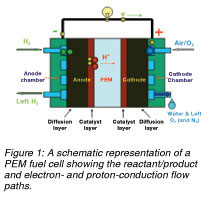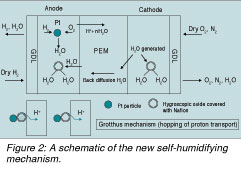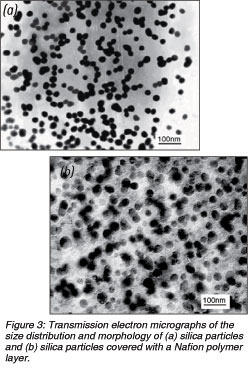|
by Ming HAN, Avier LIM, and Siew-Hwa CHAN
 he hydrogen economy offers a unique opportunity to address the greenhouse gas problem since it can decouple carbon emissions from energy use and power generation. When a fuel cell uses hydrogen, it emits water only. Nuclear options for hydrogen production as well as renewable resources such as wind and solar energy virtually eliminate greenhouse gases. he hydrogen economy offers a unique opportunity to address the greenhouse gas problem since it can decouple carbon emissions from energy use and power generation. When a fuel cell uses hydrogen, it emits water only. Nuclear options for hydrogen production as well as renewable resources such as wind and solar energy virtually eliminate greenhouse gases.
 A fuel cell constitutes an electrochemical device that converts chemical energy into electricity and heat without combustion. A fuel cell consists of an anode for the fuel and a cathode for the oxidant with an electrolyte that conducts ions between the two electrodes. In a proton-exchange membrane (PEM) fuel cell, hydrogen supplies the fuel and oxygen from the air or pure oxygen acts as the oxidant. A fuel cell constitutes an electrochemical device that converts chemical energy into electricity and heat without combustion. A fuel cell consists of an anode for the fuel and a cathode for the oxidant with an electrolyte that conducts ions between the two electrodes. In a proton-exchange membrane (PEM) fuel cell, hydrogen supplies the fuel and oxygen from the air or pure oxygen acts as the oxidant.
Figure 1 illustrates how an electrochemical reaction occurs within the cell. At the anode, hydrogen molecules dissociate, the atoms are protonised, and electrons are directed to an external circuit to form electricity; protons migrate to the proton-exchange membrane and pass through to the cathode, where oxygen combines with protons from the membrane and electrons from the external circuit to form water.
Proton conductivity of the electrolyte membrane dictates the performance of the PEM fuel cell. Membranes such as Nafion used in PEM fuel cells require sufficient water to maintain their proton conductivity. Water management and balance in PEM fuel cells is very important in ensuring not only the desired performance but also the life span of the fuel cell.
Water electro-osmotic drag and back diffusion from the cathode contribute to water transport in the membrane. The former occurs when protons migrate through the membrane from the anode to the cathode and carry water molecules with them. The water drag from the anode to the cathode runs proportionally to the proton flow and thus this phenomenon increases at higher-current density. The latter originates from the diffusion of water through the membrane, driven by the water-concentration gradient in the thickness profile. The phenomenon of water back diffusion across a membrane from the cathode to the anode usually predominates owing to the water produced at the cathode.
Because of the water electro-osmotic drag and back diffusion, the challenge lies in keeping the entire membrane properly hydrated. Scientists believe that the membrane on the anode side dehydrates, especially at a higher current density in an operating fuel cell.
 To achieve sufficient membrane hydration, passing the hydrogen or air through humidifiers normally introduces water into the cell externally. This process burdens fuel cells, however, especially for those systems constrained in size and portability. To achieve sufficient membrane hydration, passing the hydrogen or air through humidifiers normally introduces water into the cell externally. This process burdens fuel cells, however, especially for those systems constrained in size and portability.
In a recent study, scientists from the Nanyang Technological University (NTU) and PEM fuel cell supplier GasHub Technology Pte Ltd in Singapore found that the dehydration of Nafion material at the anode serves to influence PEM fuel cell performance. Maintaining the hydration of the Nafion material at the anode can significantly improve the performance of a PEM fuel cell without external humidification. Relying on their observation, the researchers invented a new self-humidifying technique for PEM fuel cells and filed a patent.
Figure 2 shows the schematic of the self-humidifying mechanism. The membrane electrode assembly (MEA) consists of an anode with added nano-scale hygroscopic oxide (silica), a cathode either with or without added nano-scale hygroscopic oxide, with a Nafion membrane sandwiched between. The nano-silica particles covered with a Nafion polymer layer can function like the proton transport from the platinum (Pt) active site into the Nafion membrane at the anode and from the membrane to the Pt active site at the cathode.
 Meanwhile, the nano-silica particles also play a role in water adsorption. When the water produced by electrochemical reaction at the cathode back-diffuses from cathode to anode, the silica, which has a hygroscopic property, should adsorb it. The water back-diffusion process also lends benefits by hydrating the membrane. Since the Van der Waals force (intermolecular forces arising from polarisation of molecules into two poles) forms a strong absorption bond between silica and water molecules, even elevated temperatures cannot desorb or release the water the silica adsorbed. The silica at the cathode could help to retain water when using dry air as reactant. Meanwhile, the nano-silica particles also play a role in water adsorption. When the water produced by electrochemical reaction at the cathode back-diffuses from cathode to anode, the silica, which has a hygroscopic property, should adsorb it. The water back-diffusion process also lends benefits by hydrating the membrane. Since the Van der Waals force (intermolecular forces arising from polarisation of molecules into two poles) forms a strong absorption bond between silica and water molecules, even elevated temperatures cannot desorb or release the water the silica adsorbed. The silica at the cathode could help to retain water when using dry air as reactant.
Figures 3a and 3b display the size distribution and morphology of the nano-sized silica particles and silica-Nafion composite (6% of silica to dried Nafion), respectively. Figure 3b shows a layer of Nafion on the surface of silica particles. The composite particles produce a wetting effect when applied to the anode under operating conditions without external humidification.
The introduction of silica particles into the active electrode layer at an appropriate amount (3% and 6% of silica to dried Nafion) does not affect the cell performances under external humidification conditions, and the introduction of silica particles into the active layer of electrode considerably improves cell performance without external humidification. Using the invented Self-Hydrating Membrane Electrode Assembly technique, GasHub Technology has launched the world's first commercialised air-breathing PEM fuel cell stack. Its light weight, compactness, and high efficiency attracted many visitors at the Hanover exhibition in 2006. The company will soon assign resellers across Europe and other regions.
 Click here to download the full issue for USD 6.50 Click here to download the full issue for USD 6.50
|


 he hydrogen economy offers a unique opportunity to address the greenhouse gas problem since it can decouple carbon emissions from energy use and power generation. When a fuel cell uses hydrogen, it emits water only. Nuclear options for hydrogen production as well as renewable resources such as wind and solar energy virtually eliminate greenhouse gases.
he hydrogen economy offers a unique opportunity to address the greenhouse gas problem since it can decouple carbon emissions from energy use and power generation. When a fuel cell uses hydrogen, it emits water only. Nuclear options for hydrogen production as well as renewable resources such as wind and solar energy virtually eliminate greenhouse gases.
 A fuel cell constitutes an electrochemical device that converts chemical energy into electricity and heat without combustion. A fuel cell consists of an anode for the fuel and a cathode for the oxidant with an electrolyte that conducts ions between the two electrodes. In a proton-exchange membrane (PEM) fuel cell, hydrogen supplies the fuel and oxygen from the air or pure oxygen acts as the oxidant.
A fuel cell constitutes an electrochemical device that converts chemical energy into electricity and heat without combustion. A fuel cell consists of an anode for the fuel and a cathode for the oxidant with an electrolyte that conducts ions between the two electrodes. In a proton-exchange membrane (PEM) fuel cell, hydrogen supplies the fuel and oxygen from the air or pure oxygen acts as the oxidant.
 To achieve sufficient membrane hydration, passing the hydrogen or air through humidifiers normally introduces water into the cell externally. This process burdens fuel cells, however, especially for those systems constrained in size and portability.
To achieve sufficient membrane hydration, passing the hydrogen or air through humidifiers normally introduces water into the cell externally. This process burdens fuel cells, however, especially for those systems constrained in size and portability.
 Meanwhile, the nano-silica particles also play a role in water adsorption. When the water produced by electrochemical reaction at the cathode back-diffuses from cathode to anode, the silica, which has a hygroscopic property, should adsorb it. The water back-diffusion process also lends benefits by hydrating the membrane. Since the Van der Waals force (intermolecular forces arising from polarisation of molecules into two poles) forms a strong absorption bond between silica and water molecules, even elevated temperatures cannot desorb or release the water the silica adsorbed. The silica at the cathode could help to retain water when using dry air as reactant.
Meanwhile, the nano-silica particles also play a role in water adsorption. When the water produced by electrochemical reaction at the cathode back-diffuses from cathode to anode, the silica, which has a hygroscopic property, should adsorb it. The water back-diffusion process also lends benefits by hydrating the membrane. Since the Van der Waals force (intermolecular forces arising from polarisation of molecules into two poles) forms a strong absorption bond between silica and water molecules, even elevated temperatures cannot desorb or release the water the silica adsorbed. The silica at the cathode could help to retain water when using dry air as reactant.
 Click here to download the full issue for USD 6.50
Click here to download the full issue for USD 6.50